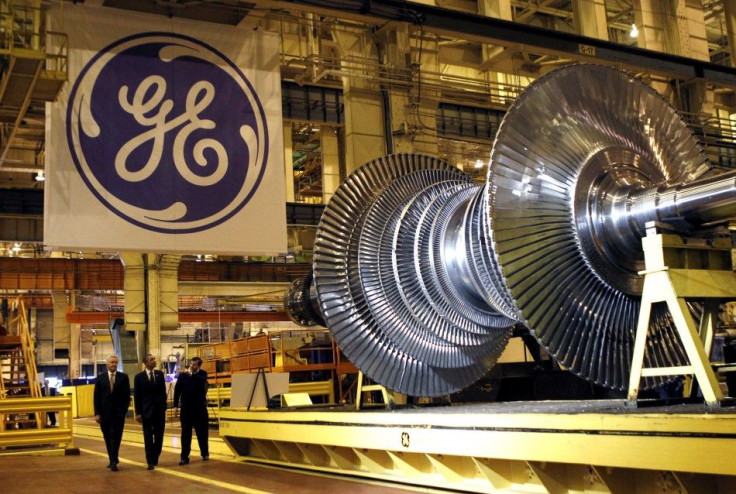GE Earnings Rise, Beating Estimates, As Industrial Business Benefits From New Orders

General Electric Co. (NYSE: GE), the manufacturing and financial conglomerate, reported first quarter earnings that beat expectations but said its revenue dipped 8 percent, with strong performance from its industrial side.
The Fairfield, Ct. company with links to Thomas Edison reported earnings per share rose 3 percent to 34, beating analyst expectations by a penny. Revenue eased to $35.2 billion.
"Today's results indicate we are achieving industrial growth," CEO Jeffrey Immelt said.
Shares of GE rose nearly 2 percent, to $19.47, in the first 90 minutes of Friday trading, They've risen about 8.5 percent so far this year.
Meanwhile, the company reported operating earnings per share rose three percent, or 17 percent excluding one-time items in 2011. Revenue at the industrial giant dropped 8 percent in the first quarter, reflecting the sales of its investments in the NBCUniversal TV network and a Turkish bank in the year-earlier quarter. Likewise, net earnings attributable to shareholders fell 10 percent to $3.03 billion.
The 8 percent drop in revenue to $35.2 billion was largely attributable to poor performance by NBCUniversal, now controlled by Comcast (Nasdaq: CMCSA), as revenues actually would have risen four percent if the division had been excluded.
Likewise, despite first quarter industrial segment profit rising 10 percent to $3.3 billion, margins fell overall. GE also took a one-time charge of $217 million for taxes and discontinued operations.
Industrial Sector Soars 14 Percent
GE's industrial segment reported 14 percent growth in revenue to $23.72 billion. GE's energy infrastructure division gained 18 percent to $11.16 billion, while its transportation division revenue surged 41 percent to $1.27 billion. Growth in the company's healthcare and "home and business solutions" divisions lagged at 5 percent for each.
GE's energy infrastructure revenues were a shining light, though, gaining 18 percent to $11.16 billion. The company's aviation division also gained, as revenues increased 12 percent to $4.89 billion.
"We have previously communicated two significant catalysts for investors: double-digit Industrial earnings growth and the return of the GE Capital dividend to the parent," Immelt said.
GE Capital's first quarter earnings were $1.8 billion, flat from the year before, but rose 27 percent excluding the 2011 sale of the Turkish bank, Garanti. New business margins "continue to be attractive" for GE Capital, and its real estate division generated its first profit since the third quarter of 2008.
"This quarter we witnessed broad-based strength in orders across all our Infrastructure businesses and in both equipment and services. Our strategy to invest in technology and global growth platforms continue to produce results with 11 percent organic Industrial segment revenue growth and 10 percent Industrial segment profit growth in the first quarter," Immelt said.
Beating Reduced Expectations
Analysts polled by Reuters expected earnings to decline sligjhtly to 33 cents per share. Operating profit was expected to be $4.77 billion for the first quarter with a profit margin of 13.8 percent, a reduction from the fourth quarter's 15.7 percent.
"We expect GE's results to be well received by the market partially due to low expectations and weak sentiment but also because of the quality of the results," wrote Scott Davis, Barclays Capital analyst.
"GE should have a good quality quarter with upside coming from the most important driver - industrial margin. Earnings quality is normally the key for GE and accelerating energy service revenue" will offset low-value equipment backlog, Davis wrote.
Pricing on orders for thermal equipment, which includes gas turbines, took a hit in the fourth quarter of 2011, dropping 12.5 percent, a decrease that continued to eat into margins during the first quarter, according to Davis.
"The strong operation experience gained by GE gas turbines with a wide variety of fuels creates favorable prospects," Paul Browning, president of GE's thermal products business, said March 28.
GE Industrial margins should finally show "signs of life despite pressure from the sell-through of last year's lower margin backlog," Davis wrote.
Gains In Energy Side
However, because of GE's large overall commitment in the energy sector and an almost 40 percent increase in electrical consumption during the first quarter, GE was expected to report major gains in its energy and gas turbine division for the quarter, Davis said. While natural gas-generated electricity made up 18 percent of U.S. consumption from 2008 to 2011, it increased to 26 percent in the first quarter. GE currently has roughly 50 percent market share of the U.S. gas turbine market.
GE's energy division grew 13 percent in the first quarter, partly due to acquisitions, according to Davis.
GE Aviation received $6.9 billion in first-quarter orders, up18 percent from the previous quarter. As of mid-March, GE had an equipment backlog of $23 billion, an increase of 7 percent.
GE's aviation division had approximately 5 percent growth and a slight expansion in margins after a weak fourth quarter, Davis wrote. Likewise, 8 percent after-market growth was projected for the first quarter, despite tough competition. GE's aviation profit margins in the first quarter were 19.5 percent, compared with 17.3 percent .
Research, development and launch expenses in GE's aviation division are expected to fall as a percentage of sales in the first quarter, Davis forecast.
The first Boeing 787 Dreamliner powered by GE's GEnx-1B engine was delivered to Japan Airlines in March. More than 1,300 GEnz-1B engines have been ordered for the Boeing 787. Orders commitments total $16 billion.
GE's real estate operations likely reduced losses in the first quarter, according to Langenberg & Co.
Meanwhile, GE reported cash and investments of $131.5 billion as of March 31, most of it in GE Capital. The company's market capitalization is $205.6 billion.
.
© Copyright IBTimes 2024. All rights reserved.





















